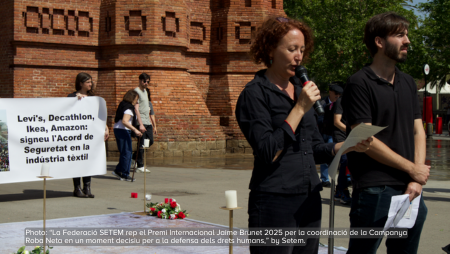Samsung, the world’s largest technology firm by revenue, continues to shift the blame to victims of its occupational disease cluster and to play off them one against another, in a move to move the cluster crisis out of public focus.
The world’s largest technology firm by revenue continues to shift the blame to victims of its occupational disease cluster and to play off them one against another, in a move to move the cluster crisis out of public focus.
At a Feb 16th media workshop on the cluster called by the Seoul chapter of the Asian American Journalists Association, a spokesman of Samsung Electronics Co., Ltd. lowered himself to brandishing a photocopy of a journal by a victim as if evidence for Samsung’s safety education for workers.
The journal is belonged to Hwang Yu-mi, a Samsung semiconductor-lab operator who died of leukemia at the age of 21 in 2007. A hard-working employee, the late Hwang detailed her work experience in the journal, which later her father Hwang Sang-ki, a founder of SHARPS, used to build a case against Samsung. No parts of her journal indicate that Samsung provided safety education to employees.
Taxi Driver Versus Samsung’s Mouthpiece
When Samsung spokesman Baik Soo-ha flaunted the late Ms. Hwang’s journal to lie blatantly, her father, Mr. Hwang, also a speaker at the workshop, was seated two seats apart from Mr. Baik on the same platform.
The AAJS invited all parties, from Samsung to SHARPS to the Family Settlement Committee, to the event. Samsung representatives attended it on condition that they would not share the platform with any advocates. The result: Mr. Hwang, a taxi driver, and Kim Si-nyeo, a homemaker and mother of a brain tumor-affected Han Hye-Kyoung, had to take on Mr. Baik, a TV journalist-turned Samsung mouthpiece, at a rare information session on Samsung’s cluster joined by tens of international correspondents based in Seoul.
Mean Attack
In this skewed setting, the Samsung spokesman took the offensive, questioning the veracity of the 223 cluster victims SHARPS has to date profiled. Mr. Baik cited SHARPS has not fully disclosed their identities.
SHARPS does not disclose a victim’s identity unless he/she consents to not only protect his/her privacy and but also shield him/her from Samsung’s attempts at intimidation and buy-offs.
There is ample such evidence. In 2010, the mother of Park Ji-yeon, a 23-year-old female Samsung employee who died of acute bone cancer, said she withdrew an administrative lawsuit for workers compensation after Samsung promised her to pay her KRW 400 million (U$326 thousand), independent weekly Hankyoreh 21reported.

Huh Jae-hyun, of Hankyoreh 21, interviewed the mother of Park Ji-yeon, a 23-year-old female victim of Samsung’s cluster. The company paid her KRW 400 million as she withdrew a lawsuit for workers compensation. The news magazine pixelated her face at her request. Source: Hankyoreh 21
Deposited After Cremation
Ms. Park’s family initially demanded KRW 1 billion (U$816 thousand) but Samsung haggled it down to 40% the request, according to the news weekly. The company deposited the hush money to the mother’s account after the daughter’s body was cremated.
She used the money to pay off debt that had ballooned to cover Ms. Park’s medical expenses. “I felt vain after paying debt,” said Ms. Park’s mother, identified only by her last name Hwang (no relation to Hwang Yu-mi). She went on to explain, “My family was used by Samsung. Samsung covered up my child’s death.”
Also, in Jan. 2011, a news show of the Korea Broadcasting System aired footage, secretly taken by Hwang Sang-ki, of Samsung managers attempting to give Mr. Hwang what they called consolation money.
How Many Are Dying and Died
Mr. Baik’s questioning of SHARPS’s data is ludicrous, even given his own admission that about 140 victims are now seeking compensation under Samsung’s own compensation scheme. All these offer a glimpse of the depths of Samsung’s cluster, highlighting the likelihood that the number of victims is higher than SHARPS’s own data.
Then, the real issue: Samsung still attempts to hinder victims and their advocates from collecting data, making it very difficult to assess how many have died, are dying, or will die because of its negligence.
Receipt or Settlement
“A victim who suffers from cancer has medical bills running up to KRW 100 million (U$816 thousand),” said Mr. Hwang at the workshop, citing anonymous sources. “Samsung demanded the victim sign a settlement of KRW 30 million (U$24 thousand) when he applied for compensation.”
It is also revealed that the company demanded compensation applicants sign a settlement agreement, a copy of which it does not provide them. Nor does it allow the applicants to photograph the document. When asked why Samsung does not provide a copy of the settlement to the victims, Mr. Baik answered, “The term ‘settlement’ is a misnomer because it is a receipt.”
“You don’t photocopy receipts to give them,” Samsung’s mouthpiece quipped.










